February 23, 2007
Air Date: February 23, 2007
FULL SHOW
SEGMENTS
Getting Cozy with Conoco?
View the page for this story
Host Steve Curwood talks with legal analyst Jonathan Turley about a brewing new scandal in Washington involving two environmental regulators and an oil industry lobbyist. (07:00)
Can Termites Save the World?
/ Bruce GellermanView the page for this story
Living on Earth’s Bruce Gellerman reports on a new frontier in the search for clean biofuels. Scientists are investigating the guts of termites and other animals for microbes and enzymes that can help break down wood and other plant material. (05:05)
Toxic Delivery
View the page for this story
Host Steve Curwood talks with Philippe Sands of London’s Centre on International Courts and Tribunals about the recent 200 million dollar payment in the case of a toxic waste dumping scandal in the Ivory Coast. At least ten people died and 75,000 sought medical help last August after 400 tons of waste generated by the Dutch company Trafigura were dumped in the capital city of Abidjan. (05:10)
A Movement Leader Speaks
View the page for this story
Host Steve Curwood talks with Nobel Peace Prize winner Wangari Maathai about the legacy of colonialism in Africa and her continued efforts to restore and preserve the world’s forests. Maathai has just released a memoir titled “Unbowed.” The interview is the second of two parts. (11:47)
Bird Flu Update
View the page for this story
Host Steve Curwood gets an update on the bird flu threat from Anthony Fauci, director of the National Institute of Allergy and Infectious Diseases. Fauci says that recent outbreaks among poultry in Britain and humans in Southeast Asia show that bird flu continues to loom as a major threat, and that humans are still unprepared. (05:35)
Under An Arizona Sun
/ Sadie BabitsView the page for this story
Sadie Babits reports from Northern Arizona on the changes that global warming is bringing to the region. Researchers are examining the past and the present to get an idea of what the future holds for a warmer, and probably drier, Arizona. (09:30)
Polk Award
View the page for this story
Host Steve Curwood announces that Living on Earth shares this year’s prestigious George Polk award for radio journalism, for the series “Early Signs: Reports from a Warming Planet.” (01:38)
This week's EarthEar selection
listen /
download
Colobus monkeys on the hunt for breakfast in the Kakamega Forest in Kenya.
Show Credits and Funders
Show Transcript
HOST: Steve Curwood
GUEST: Jonathan Turley, Phillippe Sands, Wangari Maathai, Anthony Fauci.
REPORTERS: Bruce Gellerman, Sadie Babits
[THEME]
CURWOOD: From Public Radio International - this is Living on Earth.
[THEME]
CURWOOD: I’m Steve Curwood. The latest corruption scandal in Washington is focusing on a senior Justice Department environmental official who bought a beach house with a key figure in the Abramoff case and an oil company executive.
TURLEY: Here you’ve actually got two of the chief regulators actually sharing a home with a lobbyist. So, on its face this raises obvious concerns.
CURWOOD: Also, the search for novel ways to turn weeds and other plants into something you can put into your gas tank.
SOMERVILLE: Organizations are now identifying microorganisms from all kinds of environments, such as termite guts and the ruminant of cattle and compost heaps where microorganisms are known to exist who live on breaking down cellulose.
CURWOOD: Those stories plus the second part of our interview with Nobel Peace Prize winner Wangari Maathai. This week on Living on Earth. Stick around!
[NPR NEWSCAST]
ANNOUNCER: Support for Living on Earth comes from the National Science Foundation and Stonyfield farm.
Getting Cozy with Conoco?
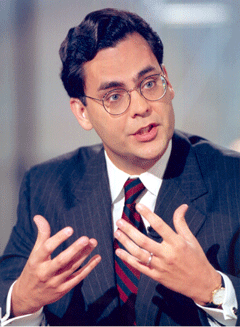
Guest Jonathan Turley is a professor at the George Washington University Law School. (Photo: George Washington University Law School)
CURWOOD: From the Jennifer and Ted Stanley Studios in Somerville, Massachusetts - this is Living on Earth. I’m Steve Curwood. Scandal continues to haunt Washington, and the latest allegations involve two top environmental regulators. Former Deputy Interior Secretary, J. Steven Griles has been under investigation in connection with the Jack Abramoff lobbying affair. Now it turns out that Mr. Griles and his girlfriend, Sue Ellen Wooldrige, purchased a million dollar beach house with Donald Duncan. He’s a vice president of Conoco Phillips, the nation’s third largest oil company.
Until last fall Ms. Wooldridge was also the top Justice Department official for environmental enforcement. And she is now under fire for signing a consent order that would allow Conoco to delay payment of more than a half billion dollars in fines and expenses to clean up a polluting oil refinery. Joining us today to talk about these developments is Jonathan Turley, he’s law professor at George Washington University in Washington D.C.
Hello Sir.
TURLEY: Hello
CURWOOD: So, what wrong with three friends going in together on a piece of real estate?

Guest Jonathan Turley is a professor at the George Washington University Law School. (Photo: George Washington University Law School)
CURWOOD: This is all a bit complicated for people outside of Washington. Can you walk me through the details of this case? Who are the officials involved in the purchase of this, ah, beach house?
TURLEY: Well first of all some of them are quite well known. The best know is J. Steven Griles who is the former deputy interior secretary who’s always been a focus of great controversy. When he was first brought into the administration a lot of environmentalists identified him and others as people that had worked for the industries that they would now regulate. There’s also Don Duncan who is the vice president of federal and international affairs for Conoco-Phillips, one of the major lobbyists in Washington as you might imagine. And then finally there’s Sue Ellen Wooldrige who’s the former assistant attorney general in charge of the environment and natural resources.
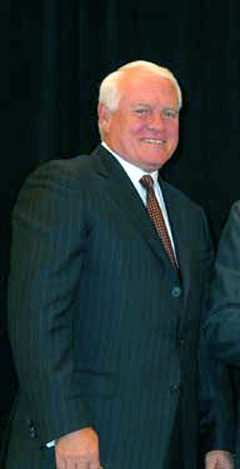
Former Deputy Secretary of the Department of the Interior: J. Steven Griles. (Courtesy of U.S. DOI)
TURLEY: It was. Conoco-Phillips came back and said we would like more time. Essentially we’re not going to fulfill the agreement that we made. And so the proposed changes would have delayed the need for the company to put in over a half billion dollars worth of emissions controls at refineries. And this was viewed by many as a signature move for the Bush administration. Sort of back door effort to help out industry avoid pollution abatement at the very time that there’s all this concern about air pollution and global warming and all the other questions that quietly people like Griles were working to relax these types of commitments.
CURWOOD: Talk to me about the half billion dollars that Conoco didn’t have to spend right away. How does that compare to their profits?
TURLEY: Well, half a billion dollars will concentrate the mind of any company even this one. This is 525 million dollars worth of abatement devices that Conoco-Phillips promised it would put in to settle that case. And when, essentially, the bill came due they said, “We prefer not to do that.” Now what was particularly strange is that these companies were having record profits. So there really wasn’t any good reason for delaying this earlier agreement.
CURWOOD: What was the role of Mr. Griles and Ms. Wooldrige in this proposed consent decree that would let Conoco off the hook for a longer period of time?
TURLEY: Well the most direct role was by Wooldrige who signed the proposed consent decree. And the role of Griles is yet to be determined. These are two individuals who may be more reluctant now to discuss their involvement with anything dealing with Conoco-Phillips. First of all Griles is under criminal investigation linked to the Abramoff matter. Also Wooldrige may face certain ethical question even ethical charges. But Congress is proceeding to investigate all of these matters.
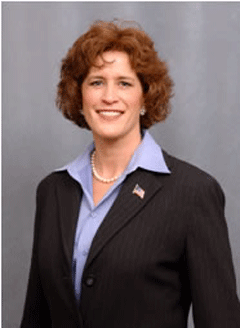
Sue Ellen Wooldridge is the Former Assistant Attorney General in charge of the Environment and Natural Resources Division at the U.S. Department of Justice. (Courtesy of U.S. DOJ)
TURLEY: Well really these are the two individuals that are the soup to nuts for environmental regulation that interior handles many of the issues that affect these corporations, ah, with the EPA they’re often the boots on the ground. And the Justice Department exercises the critical authority over whether to prosecute or enforce. So if you had to buy a house as a lobbyist with two people these would be the perfect housemates.
CURWOOD: How high do these decisions go in the Bush Administration? Who would have had to sign off on the appointments of Mr. Griles and Ms. Wooldrige?
TURLEY: That’s really what everyone’s talking about in Washington, is where the trajectory of this scandal will go. Some of the most common questions being asked around coffee shops are: who knew about the romantic relationship between these two individuals or possibly this house deal? Who were, essentially, the patrones of these individuals? Who protected Griles? I mean Griles has been radioactive for years and yet he was kept in government. He didn’t do that by himself. So what Congress is going to be looking at is not just what occurred here and how it could happen, but who were the facilitators? Who were the protectors? Who knew about this romantic relationship and its implications? Who knew about these interventions and the involvement in this consent decree? That’s really where this scandal is going. Now remember these are two very high up individuals. There’s not a lot of folks above their pay grade. So anyone above them is going to cause real problems for the Bush Administration. Just above them you’re going to start to hit cabinet officials. And just above the cabinet you’re going to hit Vice President Cheney and ultimately President Bush.
CURWOOD: Jonathan Turley is professor of public interest law at George Washington University. Thank you sir.
TURLEY: Thank you.
CURWOOD: Living on Earth contacted the attorneys for both J. Steven Griles and for Sue Ellen Wooldridge but both declined to comment. The Justice department says it is reviewing the matter.
[MUSIC: Tuung “Out The Window With The Window” from ‘Mother’s Daughter and Other Songs’ (Ace Fu Records - 2006)]
Can Termites Save the World?
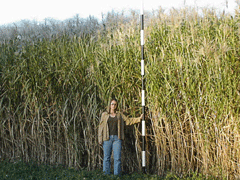
"Miscanthus growth over a single growing season in Illinois." (Courtesy of U.S. DOE)
CURWOOD: Termites. They can be really bad news if you live in a wooden home, but as scientists search for solutions to the challenge of climate change, termites might emerge as the good guys, along with an unusual plant that grows like a weed.
Living on Earth’s Bruce Gellerman explains.
GELLERMAN: In 1997 Steven Chu shared the Nobel Prize in physics by thinking small, using lasers to trap and cool atoms. Today, Chu is director of the Lawrence Berkeley National Laboratory in California. He’s switched fields to molecular biology and now he’s thinking big, very big.
CHU: Oh we want to save the world, ha, ha, ha.
GELLERMAN: Chu wants to save the world from global warming and he and colleagues from the University of Illinois Urbana-Champagne, Stanford University, and CalTech plan to do it in part with plants.
Corn and sugar cane can already be converted into ethanol which can be used in cars. But it takes a lot of energy and land to grow, harvest, and convert these foods into fuel. Chu and company have a different idea. Instead of using expensive crops which don’t give you much bang for your buck they want to distill ethanol from agricultural wastes, things like wood chips and a fast growing, tropical grass called Miscanthus. Chu calls miscanthus a miracle weed. On one experimental field 2500 gallons of ethanol were distilled from a single acre. That’s nearly three times what you get from corn.
CHU: This is a weed to behold. Miscanthus grows to 14 feet. It’s a perennial crop. Chop it off at the bottom and next year it’s 14 feet. Pretty good stuff!

"Miscanthus growth over a single growing season in Illinois." (Courtesy of U.S. DOE)
CHU: Ah right now it’s too expensive to convert.
GELLERMAN: The materials in miscanthus that Chu wants to convert into ethanol are cellulose and lignin, the woody stuff that makes plants hard. Nature deliberately makes it difficult to break down these strong substances and turn them into starch which can then be distilled. But nature also has things that can help, things like termites. That’s right termites. The pests that can eat you out of house and home.
SIMON: The termites are fantastic. We went through Africa and saw these huge termites. These guys are working like mad.
GELLERMAN: Melvin Simon, professor emeritus at CalTech thinks termites can help save the world because they can do what we can’t. When we eat cellulose we call it dietary fiber. It passes right through us. But when termites eat cellulose they call it dinner because in the termites gut are microorganisms that produce enzymes, chemicals that can break down the cellulose, again, Mel Simon
SIMON: You know what happens when the termite is born. The little baby termite hatches? It hasn’t got these enzymes, the mother regurgitates a little bit of stuff and the babies sucks that up and gets itself inoculated with the enzymes it’s going to need to make its food. Isn’t that great? (laughs)
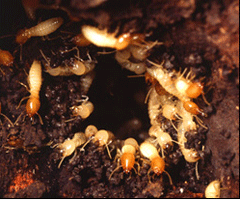
Formosan subterranean termites. (Courtesy of USDA)
SIMON: That’s the problem. Biology isn’t in a hurry. Biology has lots of time. So there are some problems speeding up the rate at which catalysts work. That’s not a simple process.
GELLERMAN: But scientists like Mel Simon are experimenting with modifying the bugs in termite guts to speed them up and they’ve got a new genetic tool to help them find promising microbes. Chris Somerville is a researcher from Stanford University and Carnegie Institution:
SOMERVILLE: Organizations are now going out into nature and identifying all kinds of environments, such as termite guts and the ruminant of cattle, and forest floors, and composite heaps where microorganisms are known to exist who live on breaking down cellulose into sugars. And now they’re determining the DNA sequence and analyzing the gene structure of these organisms to identify new types of enzymes that might be more efficient at this.
GELLERMAN: Professor Somerville is investigating how to make the cellulose in plants like Miscanthus easier to break down. Somerville’s work and those of his colleagues, Nobel Laureate Steven Chu and Melvin Simon, is funded by a 500 million dollar grant from BP Oil Company. President Bush has proposed 180 million dollars for biofuel research next year. But Somerville says it will be the profit motive not government that will drive new biofuel R&D:
SOMERVILLE: I actually believe it’s going to be possible to create a biofuels industry on a very large scale fundamentally without the government. I think that the participation of the world’s energy companies is the key ingredient.
GELLERMAN: Chris Somerville predicts you could be putting the stuff produced from termite guts eating exotic plants into the tank of your car within ten or 12 years.
For Living on Earth, I’m Bruce Gellerman
Related links:
- Mel Simon's company: Diversa Corporation
- Lawrence Berkeley National Laboratory
- Miscanthus research at the University of Illinois
[MUSIC: Efterklang “Swarming” from ‘Tripper’ (The Leaf Label – 2004)]
CURWOOD: Coming up: the final part of our conversation with environmental activist and Nobel Peace Prize laureate, Wangari Maathai. Keep listening to Living on Earth.
Toxic Delivery
CURWOOD: It’s Living on Earth. I’m Steve Curwood. In late August of last year, residents in neighborhoods around the capital of the Ivory Coast, Abidjan woke up feeling nauseous and gasping for breath. Some were also vomiting and bleeding from their noses. Within a few days at least ten people had died—the actual number is unclear, and an estimated 75,000 had sought medical help.
The cause: hundreds of tons of toxic waste from Europe, including highly caustic chemicals, that had been dumped illegally from the Probo Koala, an oil tanker owned by the Dutch company: Trafigura. A cleanup began almost immediately, but three company officials were jailed in September and were held until earlier this month. That’s when Trafigura paid the government of the Ivory Coast about $200 million, but accepted no liability for the incident. On the line with us is law professor Philippe Sands. He directs the Centre on International Courts and Tribunals at the University College London.
Hello sir!
SANDS: Hi, very nice to join you.
CURWOOD: So this 200 million dollars, how does that compare to the health crisis that erupted in Abidjan after this dumping?
SANDS: Well, it’s difficult to give a precise, ah, view on that because it seems like a very large sum of money. On the other hand the very large volumes of hazardous wastes, over 400 tons by some accounts, obviously had been spread to a number of different sites and seem to have caused very significant health consequences. So it’s important to note, on the terms of the agreement, neither side accepts any sort of liability for the consequences. So it’s called, in legal terms, it’s an ex gracia payment. The hope of both sides is that this is going to sort it out once and for all.
CURWOOD: How does a settlement like this factor into the terms of the Basel Convention which prevents one country from dumping toxic waste on another country?
SANDS: The Convention seems to have been violated. And the Convention establishes very strict rules on notification, on prior agreement, when hazardous waste is taken from one country to another country. And here obviously something went seriously wrong. But looking on the bright side it’s pretty clear that if the Basel Convention had not been in place there would not have been a settlement of this kind. Now that is not to say the rules under the Basel Convention are adequate. There’s been a call as a result of this incident and other incidents, for a tightening up of the rules to make them even stricter.
CURWOOD: Cote D’Ivoire is a divided country right now, at war with itself. How well do you think the government is going to be able to handle these funds?
SANDS: Well that’s the big question. I mean how well is any government able to handle the sharing of large funds in natural or other types of disasters such as this? I mean you know we’ve seen in the United States with Katrina the terrible problem of getting monies around. We’ve seen in the United Kingdom, my own country, situations where bombings have happened in London and questions come up of compensation: who gets what. These are very difficult issues and I think for a government like the Cote D’ Ivoire, which as you say finds itself deeply divided at the moment, within its government as well. There are going to be huge pressures to divert some of the funds elsewhere, to use them for particular ways. In the Cote D’Ivore, as for any country, 200 million dollars is a pretty large sum of money. And it will be very important to make sure, firstly that the money goes where it should go and secondly that the costs of administering that fund don’t eat up a significant chunk to avoid them going where they ought to go.
CURWOOD: How much of a deterrent is this settlement for another company that might be thinking about it?
SANDS: That’s an interesting question, an important question. I mean, Trafigura must have taken the view that paying 198 million dollars or there abouts, was a price worth paying to get rid of this issue. Um, what that means for other companies is not clear. But it will certainly concentrate companies’ minds, ah, that if they violate the rules, if they’re caught and if they’re subject to claims such as this, they’re not going to get away scott free. Others will say that this was a relatively small sum of money, ah, given what its liabilities could have been under various court proceedings and that may yet turn out to be the case. But for the time being I think that companies that are thinking about transporting waste around the world will think a little bit more carefully about evading their responsibilities under international conventions. And 200 million dollars is 200 million dollars.
CURWOOD: I understand that eventually this material was taken to France where it was disposed of properly. Why didn’t it stay in Europe to begin with?
SANDS: Well, that is a very powerful question. There is an emerging principle of international law called the principle of proximity. And the principle of proximity says hazardous materials should be disposed of in the place in which it is produced. And on that principle it ought to have been disposed of where it was generated in the first place.
CURWOOD: Philippe Sands is a law professor and Director of the Center of International Courts and Tribunals at University College in London. Thank you so much sir.
SANDS: Delighted to join you.
Related links:
- The Basel Action Network
- The United Nation's Environment Programme (UNEP) on toxic trade
- To view the United Nations Disaster Assessment and Coordination (UNDAC) team's report on the toxic dumpings in Abidjan, Cote d'Ivoire click here.
[MUSIC: Jens Lekman “Pocketful of Money” from ‘Oh You’re So Silent, Jens’ (Secretly Canadian – 2005)]
CURWOOD: We’re online at L-O-E dot org where you can hear the program anytime. And we’re always eager to hear your thoughts . You can reach us at comments at l-o-e- dot org. Once again comments at l-o-e dot org. Or call our listener line at 800-2-1-8-9-9-8-8, thats 800-2-1-8-99-88. Our postal address is 20 Holland street, Somerville, Massachusetts, 02144.
A Movement Leader Speaks
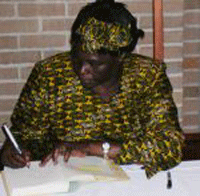
Wangari Maathai signs books at College of the Holy Cross in Worcester, Massachusetts. (Photo: Mia McDonald)
CURWOOD: We return now to a much happier story from Africa, that of environmental and human rights activist, Wangari Maathai. Professor Maathai has written a memoir recounting her rise from life as a village girl in the countryside of Kenya to a celebrated green leader and winner of the Nobel Peace Prize. The book is called Unbowed.
Last week we spoke with her about her education and her early activism. We continue the conversation this week, beginning with a tale she tells in her book about a fig tree near her childhood home.
MAATHAI: Well, the story of the fig tree is a very interesting story because when I was growing up I was, like all of the other girl children of my age. I would collect firewood. I would fetch water from a nearby stream. And I remember that my mother told me not to collect the firewood from the fig tree. And I asked her why? And she said, “because that tree is the tree of God. We don’t burn it. We don’t cut it. We don’t use it for building. We let them stand for as long as they are able to.”
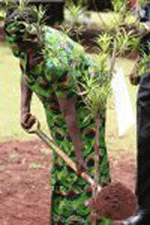
Wangari Maathai planting
a tree at the Outspan Hotel,
Nyeri,Kenya, to mark the
launch of her autobiography,
Unbowed. (Photo: Wanjira
Mathai)
And I didn’t think about it until much much later when I became, ah, more conscious about the role of trees in the environment. And then I appreciated the wisdom of our people in not cutting some of these trees, treating them as if they were sacred. And it was much later that I realized that these trees were very important for the stabilization of the land. Stabilizing the soil, making sure that you don’t have landslides and also making sure that a lot of the water that is in the ground is brought up from the underground from the belly of the earth along the roots of these trees. So they were very very important in the ecological system.
CURWOOD: Now when you went back as an adult in your later years what had happened to that tree?
MAATHAI: Unfortunately, when we introduced cash crops-coffee, tea, sugar canes- the tree was considered useless. It was no longer a holy tree because people were now Christians. And so it was cut to make way for tea bushes. Fortunately nothing has ever grown in the particular site where that tree was. It is as if only a fig tree was supposed to grow there.
CURWOOD: And what happened to the water? The…you said that the roots of the fig tree would bring up water. What happened to the water that was there?
MAATHAI: Very close to the fig tree there was this little stream. And I mention in the book that I used to play, ah, with frog eggs and with tadpoles in this steam. And this is the stream from which I would fetch water for my mother. But when this tree was cut the stream also dried up. We often take these trees, we often take the ecosystem for granted. Partly because we don’t understand how they are linked with each other and how together they create a harmony that makes life possible.
CURWOOD: I’d like to talk to you directly about your memoir for a moment which came out not so long ago. And it is fittingly called....
MAATHAI: Unbowed.
CURWOOD: And can you tell me about the title?
MAATHAI: We were trying to reflect the fact that even though we have gone through such a difficult life and we have gone through so many trials and tribulations we continue to walk tall and proud, unbowed.

Wangari Maathai signs books at College of the Holy Cross in Worcester, Massachusetts. (Photo: Mia McDonald)
MAATHAI: Well, that is the tragedy of any people who are colonized. Those who colonized came to convince people that they are backwards, that they don’t have anything worth saving, that they need to emulate the lifestyle and the faith of those who have colonized them. And because those who colonized were often, you know, they had advanced technology, they came by ship, by horses, by trains. And so the natives were completely overwhelmed by the technology and the knowledge that the newcomers seemed to have. And so in that process the colonizers as I say, had perfected a system that was extremely powerful. And especially religion because when you tell people about a god, a god you never see, a god you can never ask questions. You can never go to God and say, “God, are these people telling me the truth or are they manipulating me so that I am vulnerable.” You can’t ask God those questions so it’s a very very powerful way of controlling people so that you can access and exploit their resources.
CURWOOD: At one point you write, that they uh and I’m quoting here that, “the trauma of the colonized are rarely examined. Steps are rarely taken to understand and redress it. The psychological damage passes from one generation to the next until victims recognize their dilemma and work to liberate themselves from the trauma.” How do you see that psychological damage from the years of colonization under the British, still present today?
MAATHAI: Well it is everywhere. You see it everywhere. You see it in the way people are disempowered, in the way that people don’t believe in themselves, in the way that people believe that they are less than those who colonized them. And it is made worse by the fact that those who became the new rulers who are natives , even they have that indoctrination. They literally continued to govern in the same way that the masters were governing. And that has been part of the problem of Africa.
We need to decolonize the minds of people who have been colonized. Until you decolonize those minds it’s very very difficult for the colonized to liberate themselves from the burden of self-doubt, the burden of self, um... sometimes-even self-hatred that they have. And the tragedy is they don’t know that, that’s what happened to them. Because quite often what has happened to them is projected as progress. It is projected as development.
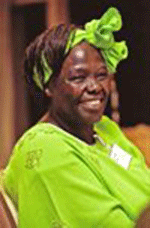
Wangari Maathai in Japan,
February 2005. (Photo:
Mainichi Corporation)
CURWOOD: I know one area where you’ve been raising awareness, ah, is the importance of the vast tropical rainforest in Africa’s Congo Basin, which is so much less known than the Amazon rainforest. How’s that going?
MAATHAI: That’s going well. And I’m very very happy that the climate change discussion is gaining momentum. And people are recognizing that one of the ways in which we can help the planet is by planting trees but also by protecting the trees that are standing. So I hope that governments that have money will help the African governments so that they can protect that forest from logging. Because it’s also important to say that the logging is not being done by local people. The logging of these forests is usually done by big timber companies from developed countries.
So considering that it is the developed countries that have contributed so much to the green house gasses that are causing the warming up of the earth it is only appropriate that they too should participate in assisting governments, not only to stop the logging , but to help with the rehabilitation of the logged areas.
CURWOOD: I want to mention something personal to you. I live in New Hampshire and it’s an old old house, 250 years old, and there’s a sugar maple, there’s a bunch of sugar maples, that were planted probably not long after the house was built and one of them has run out of time. It’s probably 175 years old. The wires that have been holding it together and the other efforts that have been made to keep it going- just nothing more can be done. And it has to come down; in fact I think it’s going to come down tomorrow.
MAATHAI: I’m so sorry to hear that. But it also means that we understand that all living things come to an end. And the only thing we can say is that is after so many years of service that tree is ready to be recycled. How wonderful it would be if all of us would be recycled when our time comes and we would be able to say, like that tree, “I have done my part.”
CURWOOD: Professor Maathai thank you so much for being with us today.
MAATHAI: Thank you.
CURWOOD: And I want to give you the opportunity to say anything else that you’d like to say.
MAATHAI: Well I would just like to remind our listeners that recently in Nairobi we launched a billion tree campaign. We are appealing to all the people in the world, throughout the world where ever you are, who ever you are if you can plant a tree... there are six billion of us. If at least one out of six planted a tree we would very easily reach our target. It is not as if we will solve all the crises of the climate with those billion trees, but at least it’s one way of doing something to contribute towards solving the problem. Let us be part of the solution and not part of the problem.
CURWOOD: Wangari Maathai, winner of the 2004 Nobel Peace Prize, thank you so much.
MAATHAI: Thank you very much .
CURWOOD: Wangari Maathai is Kenya’s Deputy Minister of the Environment and founder of the Greenbelt Movement. Her new memoir is called “Unbowed.” You can hear the first part of our conversation with Wangari Maathai… as well as a one-hour documentary about her life at our website, l-o-e dot o-r-g. You can also find information there about her campaign to plant one billion trees. The only thing is, you have to help. I’m already on the hook to replace my big old maple tree that has to come down.
Related links:
- The Green Belt Movement
- Green Belt Movement blog
- Wangari Maathai's "Unbowed"
- UNEP's "Plant for the Planet: Billion Tree Campaign"
[MUSIC: Peter Gabriel & Youssou N’Dour “Shaking The Tree” from ‘Shaking The Tree: Sixteen Golden Greats’ (UMG Recordings – 1990)]
CURWOOD: Just ahead, some good news, kinda, about the bird flu. There’s a vaccine for humans, but it only works about half the time and there’s not enough for everyone. Keep listening to Living on Earth
ANNOUNCER: Support for the Environmental Health Desk at Living on Earth comes from the Cedar Tree Foundation. Support also comes from the Richard and Rhoda Goldman Fund for coverage of population and the environment, and from you our listeners and from member stations. This is Living on Earth on PRI- Public Radio International.
[MUSIC: The Octopus Project “Hold The Ladder” from ‘One Ten Hundred Thousand Million’ (Peekaboo – 2005)]
Bird Flu Update
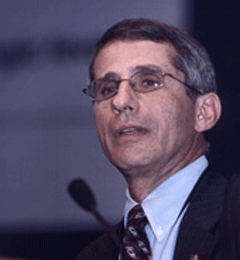
Dr. Anothony Fauci is the Director of the National Institute of Allergy and Infectious Diseases at the NIH (Courtesy of NIH)
CURWOOD: It’s Living on Earth. I’m Steve Curwood. With the exception of a recent culling of a turkey flock in the UK, the H5N1 bird flu has stayed mostly out of the news since a flurry of concern more than a year ago. About 200 people have died from the disease, mostly from direct contact with infected birds, but so far there has been no sign of the pandemic that is expected if the H5N1 flu were to mutate into a form that can be easily transmitted among humans.
For a check up on the bird flu, we turn now Dr. Anthony Fauci. He runs the national institutes of Allergies and Infectious diseases. Thanks for joining us.
FAUCI: Thank you it’s good to be here.
CURWOOD: So when we last checked in with you in March of 2005 there was quite a bit of activity and discussion about the avian bird flew migrating into humans. And then things have been pretty quiet. And then just recently there has been a bit more news. So where are we now on the threat of this possible pandemic?
FAUCI: Well, the threat really has remained about the same. It has not gotten worse nor better. There’s still this smoldering activity of not being able to eliminate the infection of H5N1 among bird flocks. And it continues to smolder in Indonesia and Southeast Asia and then most recently in the turkey farm in the UK. And as long as there are chickens that are infected and sick and dying there’s always the possibility of it, as we say jumping species from the chicken or the turkey to the human. That has not occurred in the UK but in other parts of the world like Southeast Asia there have been a steady trickling in of cases.
CURWOOD: Now when we last spoke you were in the midst of a vaccine project here in the United States. What’s currently happening with that?

Dr. Anothony Fauci is the Director of the National Institute of Allergy and Infectious Diseases at the NIH (Courtesy of NIH)
FAUCI: Well, it was successful in many respects in that the H5N1 Vietnamese strain that was being tested has shown to be predictive of being protective. That was the good news. The sobering news is that the dose required to get to that level of immunity was prohibitively high and the protective immunity was only seen in about 50 percent of the people. Since that time and since we last spoke there’s been a considerable amount of work done on the use of vaccines together with adjuvants. And an adjuvant is a compound when given with the vaccine amplifies, expands, and heightens the immune response. We needed that because we needed to get away with a much lower dose to induce a protective response. So I think that’s going to be very helpful if and when we come to the point of needing to make large amounts of vaccine.
CURWOOD: Do we have one today?
FAUCI: Well, you know, we have it. We don’t have enough to have a meaningful impact if we are confronted with a real pandemic influenza among humans. But actually having a vaccine in hand is not anything major there. It’s getting enough doses that can be distributed in case we do in fact have a human pandemic.
CURWOOD: So where are we in the vaccine process?
FAUCI: Well in the vaccine process there are a number of things that are going on in parallel. The classic way that we traditionally get a vaccine for influenza is to grow it in eggs to get the product; either the whole virus that you then kill and use as a vaccine or you break up the virus and you use its components. There are a number of companies that are taking that approach. In parallel with that are a number of organizations, researchers, and companies, which are using the more modern vaccine techniques which we call recombinant DNA technology. In other words you don’t have to deal with the entire virus itself. You can use the molecular genetic capability of using just the components of the virus that are important for the vaccine. One such trial was actually just started in an early phase just a couple of weeks ago.
CURWOOD: We hear that Tamiflu isn’t particularly effective anymore against the bird flu. Um, how true is that?
FAUCI: Well, it depends on what you mean by particularly effective against the bird flu. If you’re talking about resistance of the virus to the Tamiflu effect that still most of the isolates that we get right now are actually sensitive to Tamiflu. However there’s a broader point with Tamiflu and other existing antivirals. And that is the original conditions for which it was approved by the FDA was that if given within the first 24 to 48 hours Tamiflu can diminish the duration of symptoms by about one and a half days. We have no idea how well Tamiflu will perform if given to people who are desperately ill with a pandemic flu.
CURWOOD: How worried are you now about an avian flu pandemic among humans?
FAUCI: Well, I think that pandemic is going to occur sometime in the future. We’ve had three of them of varying degrees of severity in the 20th century. It is highly likely that within a reasonable time in the 21st century we’ll have one. Whether that’s going to be the currently circling H5N1 we have no idea. We do know that pandemics do occur. So if there’s anything positive going on right now I think it’s focusing our attention, and a wake up call, that a pandemic is a possibility. It may not occur with this virus. It may not occur this year, next year, or the year after, but eventually we need to be prepared for a pandemic flu. You need to prepare for the worst.
CURWOOD: Anthony Fauci is director of the National Institute of Allergy and Infectious diseases. Thank you so much sir.
FAUCI: You’re quite welcome. Good to be here.
Related links:
- National Institue of Allergy and Infectious Diseases
- Centers for Disease Control and Prevention: Avian Influenza
[MUSIC: The Album Leaf “Red-Eye” from ‘Into the Blue Again’ (Sub Pop – 2006)]
Under An Arizona Sun
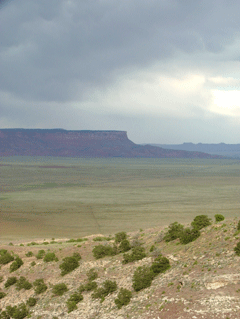
Juniper has taken over where piñon once stood. Drought, bark beetles and a warming climate have killed thousands of piñons in Northern Arizona. (Photo: Sadie Babits)
CURWOOD: Scientists at the National Center for Atmospheric Research tell us that the western part of the United States is feeling the effects of climate change more than the East right now. And certainly one part of the West where changes are becoming more tangible is the state of Arizona. As Sadie Babits reports researchers are looking at the region’s archeological past to help understand the new present and the likely future.
BABITS: Ken Cole’s eyes twinkle when he talks about ancient trash heaps. He’s a research ecologist and he studies “middens” – centuries old stashes left behind by… desert pack rats. Cole holds one in his hand that’s more than two thousand years old.
COLE: This fossil here is from Whitmore Wash. This is a place 100 km up river from Lake Mead and this is one of the ways that we’re studying how plants react to climate change.
BABITS: This midden is a treasure trove of desert ecology, a nest of seeds, twigs, leaves even feces all glued together by viscous thousand year old rat urine.
COLE: If this is under a ledge that doesn’t get any rainfall falling on it, then it’s just gonna stay there forever – and the plant bits are not gonna decompose because while they’re incased in this rat urine. They’re essentially mummified.
BABITS: Cole carbon dates his samples here at the USGS Southwest Biological Science Center in Flagstaff. Some of the middens date back to the end of the last glacial period. Scientists know that at that time, plants and animals were on the move.
COLE: If you get the climate warming suddenly like it did 11,600 years ago, plants will adjust very rapidly when moving up hill, say to a mountain top, but more slowly when moving northward a long distance.
BABITS: During that last warming period, the junipers, the scrubby plant down in the Grand Canyon, died off. Young juniper plants migrated up to the rim of the canyon in search of the cooler temperatures they favor. Researchers observe something similar happening today in Northern Arizona.

Juniper has taken over where piñon once stood. Drought, bark beetles and a warming climate have killed thousands of piñons in Northern Arizona.
(Photo: Sadie Babits)
[DRIVING SOUNDS]
Biologist Neil Cobb drives his Toyota truck up a snow covered mountain road. Cobb loves this land, this living laboratory. He leads the Merriam-Powell Center for Environmental Research in Flagstaff. As part of his work, he’s been cataloguing dead pinion pines up here. It’s earned him the nickname Dr. Death.
COBB: I came here in 1985, um you’d be very hard pressed to find a dead piñon or juniper anywhere. And then 2002 hit and we just had spectacular mortality with piñon.
BABITS: In 2002, Arizona was six years into a severe drought that continues today. Then Bark beetles multiplied in the drought-stressed trees, finishing the piñons off.
[CAR DOOR SLAM]
COBB: Hi dorks.
[WALKING IN SNOW]
BABITS: Today what was a closed woodland has turned to open scrubby juniper.
COBB: And you can see, we’re actually walking through it now so almost every live tree you see are junipers. All the carcasses are piñons. It used to be a more 50/50 or 60 % pinion 40 % juniper and now it’s almost, pretty much 100% juniper.
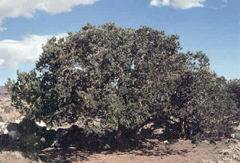
The piñon pine is the most drought-resistant of all the pines in Arizona. (Courtesy of Arizona Game and Fish Department)
COBB: What will happen to these communities underneath these dead trees? Will invasive species come in? If something like cheatgrass moves in and then alters the fire regime so that we get a lot more fires , that could really, well permanently affect the ecosystem.
BABITS: Cheatgrass isn’t here yet. Drought has so far kept this western scourge at bay. But piñon shows no sign of return yet.
COLE: As an ecologist it’s exciting to see change like this it’s very humbling something so drastically happen over a very short period of time.
BABITS: Back in the office, research ecologist Ken Cole’s climate models, show Arizona’s signature piñon trees will vanish from the state within this century. Cole says they’ll take root, instead, in northern New Mexico and Colorado.
COLE: Most of the major plant species, I think, like piñon pine that has a very wide distribution or creosote bush, that has a very wide distribution, I think they are very adaptable to different climates and they are spread in wide places. I don’t think they will have any problems. It’s the rare species…
BABITS: Like the famed Joshua trees in Joshua Tree National Park over the border in California. Cole predicts these trees, will migrate out of the park that bears their name.
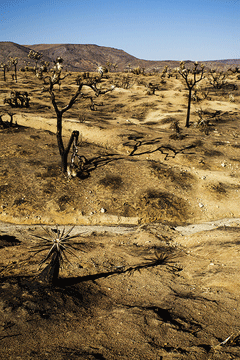
A landscape of burnt Joshua trees in Joshua Tree National Park, Twentynine Palms, CA. (Photo: Neil Earnshaw)
That’s the future. The present is fire. Last year was the most severe in a series of intense fire years. Nine million acres burned throughout the country including in Arizona.
[AIR TANKER SOUND]
BABITS: Air tankers are more and more a common sound, flying at all hours of the day, sometimes for days at a time. If you’re lucky, from a distance you watched them drop their orange-red fire retardant. Less lucky and you see the flames or feel engulfed in the smell of burning wood and falling ash.
WUERTHNER: We’ve always had big fires
BABITS: George Wuerthner is an ecologist and editor of a new book on wildfire.
WUERTHNER: But one of the things that global warming is doing is increasing or exaggerating those, some of those conditions. In other words warming prolongs the dry season, keeps humidity lower. Warming, in a lot of cases, extends drought and you also tend to get an increase in the velocity of winds. So all the conditions that make for big fires are increased by global warming.
BABITS: The National Interagency Fire Center, says the country’s fire season is now year round. And in Arizona that fire season is partly fueled by drought.
Arizona’s drought has dropped reservoir levels at Lake Powell, which provides water and power to people throughout the Southwest. Bruce Hungate directs the Western Regional Center of the National Institute of Climatic Change Research.
HUNGATE: We can’t say with any certainty that this specific drought is due to more CO2 in the atmosphere but what we can say is this is a really extreme drought it’s consistent with what the types of responses in the climate system that we ought to expect from climate change.
BABITS: The desert Southwest may have been settled during an uncharacteristically wet period, giving Westerners a false impression of what’s normal. Climate change may magnify this harsh reality and that worries biologist Neil Cobb.
COBB: If the drought continues and temperatures increase and they exacerbate that drought, it looks bleak for a lot of ecosystems. And the only thing that I can see really changing that is increased precipitation.
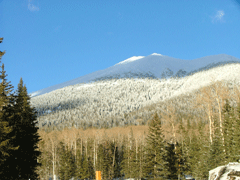
The San Francisco Peaks dominate the Northern Arizona skyline outside Flagstaff. Snow is rare these days. (Photo: Sadie Babits)
BABITS: And that’s where climate models don’t help much yet. Ken Cole explains, there’s no consensus on how much rain the desert sky will yield in future years.
COLE: Some of the models would suggest that this drought may be a permanent feature of our new climate. Other models don’t really see that happening, they see perhaps an increase in summer rainfall, ah some even an increase in winter rainfall. But regardless of what the rainfall is doing, most of the models, or all the models, show a significant increase in temperature.
BABITS: Increase in temperature. That’s a sobering prospect in Arizona, especially in Phoenix, the nation’s sixth largest city, which already bakes at over 100 degrees every afternoon, all summer long.
For Living On Earth, I’m Sadie Babits in Flagstaff.
Related links:
- USGS Southwest Biological Science Center
- Northern Arizona University's Merriam-Powell Center for Environmental Research
- National Interagency Fire Center
- DOE National Institute for Climatic Change Research
- U.S. Global Change Research Program
- Joshua Tree National Park
[MUSIC: Amina “Skakka” from ‘Animamina’ (Worker’s Institute – 2005)]
Polk Award
CURWOOD: Climate change has been a key topic for Living on Earth over the past fifteen years. And I’m pleased to report that our special series on the early signs of climate change around the world is sharing this year’s prestigious George Polk Award for radio journalism. Our eight stories, from around the world, were produced together with the University of California at Berkeley Graduate School of Journalism, Salon dot com, and American Public Media.
Eleven UC Berkeley graduate students traveled to the shores of Lake Tanganyika, to the crowded delta of Bangladesh, the snowy slopes of Mount Kilimanjaro and to the Andes to bring back tales like this one, of the real-life miseries and perils already caused by global warming.
CORNEJO [VOICEOVER]: Global warming is not the fault of third-world countries. We’re dancing at a party that we didn't even want to attend. But we’re beginning to change our habits anyways, and we'll have to keep doing that. If we don't, climate change will grab hold of us and we’ll disappear.
CURWOOD: A special thanks and congratulations to those student reporters, and also to Sandy Tolan, long time Living on Earth contributor and UC journalism professor who conceived the idea. And a big tip of the hat to Living on Earth’s Chris Ballman, Dennis Foley and especially Ingrid Lobet- who did the lion’s share of the editing with my assistance. Living on Earth is proud to be in fine company with eleven other news teams that won the Polk this year, including High Country News for Political Reporting and the Los Angeles Times for Environmental Reporting
You can find links to works of all the winners on our web site, l-o-e.org and also an interview with Ken Weiss ,co-author of the LA Times series on our altered oceans.
That’s www.loe.org.
Related links:
- Living on Earth's Special Series "Early Signs: Reports From a Warming Planet"
- 2006 George Polk Award winners
- To listen to an interview with 2006 George Polk Award-winner and Los Angeles Times reporter Kenneth Weiss about his 5-part winning series "Altered Oceans" click here
CURWOOD: Next week on Living on Earth a landmark building from New England’s industrial revolution has lain fallow for years. Now a developer is reviving it for a new time using clean and renewable geothermal energy.
ANSIN: We decided if we’re going to bring this building back, let’s bring it back in a way that minimizes the impact on the environment and let’s respond to the people who are coming here to buy condos. These are people who grew up in the 60’s and 70’s, who want to live their ideals.
CURWOOD: Bread, roses and geothermal energy, next time on Living on Earth.
[MONKEY SOUNDS]
CURWOOD: We leave you this week back in East Africa, home of Mt. Kilimanjaro and Wangari Maathai.
[COLOBUS MONKEY CALLS: “Colobus Monkeys” recorded by Douglas Quin in the Kakamega Forest, Kenya for ‘Pulse of the Planet: Extraordinary Sounds from the Natural World (Pulse- 2002)]]
CURWOOD: In the pre-dawn hours, Colobus monkeys are beginning to wake from their slumber in the trees of the Kakmega forest in Kenya.
[COLOBUS MONKEY CALLS]
CURWOOD: The troop’s vocalizations echo across the jungle canopy as they regroup and start their search for breakfast. These contact calls were recorded by Douglas Quin.
CURWOOD: Living on Earth is produced by the World Media Foundation. Our crew includes Ashley Ahearn, Eileen Bolinsky, Bruce Gellerman, Ian Gray, Ingrid Lobet, Emily Taylor, Peter Thomson and Jeff Young - with help from Bobby Bascomb, Kelley Cronin and Jeff Turton. Our interns are Paige Doughty and Meghan Vigeant. Dennis Foley is our technical director. Alison Lirish Dean composed our themes. I’m Steve Curwood, our executive producer. You can find us anytime at l-o-e dot org. Thanks for listening.
ANNOUNCER: Funding for Living on Earth comes from the National Science Foundation, supporting coverage of emerging science; And Stonyfield Farm Organic yogurt and smoothies. Stonyfield pays its farmers not to use artificial growth hormones on their cows. Details at Stonyfield dot com.
Support also comes from you our listeners, the Ford Foundation, the Park Foundation and the Saunders Hotel Group of Boston's Lennox and Copley Square Hotels. Serving you and the environment while helping preserve the past and protect the future, 800-225-7-6-7-6.
Living on Earth wants to hear from you!
Living on Earth
62 Calef Highway, Suite 212
Lee, NH 03861
Telephone: 617-287-4121
E-mail: comments@loe.org
Newsletter [Click here]
Donate to Living on Earth!
Living on Earth is an independent media program and relies entirely on contributions from listeners and institutions supporting public service. Please donate now to preserve an independent environmental voice.
NewsletterLiving on Earth offers a weekly delivery of the show's rundown to your mailbox. Sign up for our newsletter today!
 Sailors For The Sea: Be the change you want to sea.
Sailors For The Sea: Be the change you want to sea.
 The Grantham Foundation for the Protection of the Environment: Committed to protecting and improving the health of the global environment.
The Grantham Foundation for the Protection of the Environment: Committed to protecting and improving the health of the global environment.
 Contribute to Living on Earth and receive, as our gift to you, an archival print of one of Mark Seth Lender's extraordinary wildlife photographs. Follow the link to see Mark's current collection of photographs.
Contribute to Living on Earth and receive, as our gift to you, an archival print of one of Mark Seth Lender's extraordinary wildlife photographs. Follow the link to see Mark's current collection of photographs.
 Buy a signed copy of Mark Seth Lender's book Smeagull the Seagull & support Living on Earth
Buy a signed copy of Mark Seth Lender's book Smeagull the Seagull & support Living on Earth

